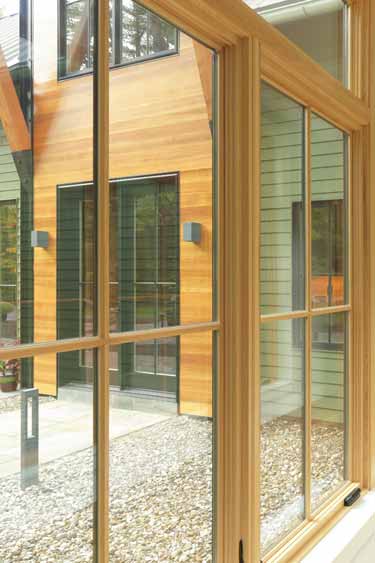Where the Future Embraces the Past
Nestled on property that is part of a summer community near Fourth Lake in the Adirondacks sits a stunning contemporary home owned by Jeanine and Ron Pastore.
It is the result of collaboration between the homeowners, architect Brett Balzer of Balzer & Tuck Architecture, and Jim Sasko, principal of Teakwood Builders.
The home is made for outdoor family living. The doors to the kitchen and dining area all lead to an open courtyard that is perfectly suited for large gatherings of family and friends—plus neighbors—who come around often and are warmly welcomed.
The Fourth Lake Association was established by Brooklyn schoolteachers in 1915 and incorporated in the 40s. Frank and Lillie Ross arrived in Fourth Lake in 1915 and built a small cottage. Ross induced his friend Anton Buchbinder, a teacher at Brooklyn Technical, to join him for the summer vacation. As Paul Taylor noted in the community’s 100th anniversary commemorative scrapbook, “He knew right away from the sparkle of the water, the majesty of the mountains, the fragrance of the pine needles—that he’d discovered a piece of paradise. When he got back to Brooklyn, he spread the news to other public school teachers who had young families, adventurous spirits, and unencumbered summers.”
As these city dwellers flocked north to the Adirondacks year after year for a retreat from sweltering summers in the city, they soon formed their own close-knit community, living in small camps. Many of these homes were built from kits, which companies sold through catalogs in the first half of the 20th century.
Jeanine’s grandparents (Sobell) bought one of the kit houses in 1941, from the previous owners, who built it in the mid-20s. It was a three-season cottage-style house with a wrap-around porch and no foundation or insulation. This is where the family spent most of their summers. It was also the scene of many gatherings—the front lawn was used as a dance floor and the porch was a stage for recitals, performances and games.
Summers were filled with square dancing, potluck dinners, and hours spent on the beach. This spirit of community still exists today. It’s not uncommon for neighbors to just drop by and spend an hour or two…or more. As Brett put it when designing the new home, “This is the kind of place where doors are never locked and where afternoon gatherings turn into evening meals, which turn into wine by the fire.” Today, more than 60 families are part of the community, many who grew up spending their vacations with each other and creating memories together.
Jeanine and Ron took over ownership of the camp in 1993 after her grandmother passed away. The couple spent a good twenty-five summers there with their children and extended family. While the camp had been updated in the 70s with insulation, skylights and a new kitchen and bath, by 2016, it was clear that some of the original elements had become old and tired. Structural failures and moisture-related issues had gotten to a point of no return, and renovation was not an option.
By this time, Jeanine and Ron were seasoned homebuilders. They had already tested the waters when they built a custom arts and crafts primary residence in Massachusetts. It was a challenging time. They started building in 2000, during the dot-com building boom when architects and good builders were hard to come by, and 9/11 also happened in 2001 while the house was still under construction. They were on the job site almost daily, working out details with the builder. But this prepared them well for their new custom home project at Fourth Lake.
“For our Fourth Lake home, we wanted a more contemporary design that reflected what we loved about the cottage, with the comfort of high-end materials and construction. What I liked most about the original cottage was its single level and cozy feel of an Adirondack getaway home. It was bright and airy, and nestled into the topography of the lot. We also wanted to preserve the original footprint and not design a house that was too big, which would overwhelm the site and depart too dramatically from the camp heritage. We wanted an updated Adirondack camp,” said Jeanine.
The Pastores met with Balzer and Tuck Architects and were impressed with the company’s approach to design and its vast portfolio. Their vocabulary was what the Pastores wanted: wood, stone, and iron melded into the natural surroundings.
“Working with Brett and Christine was a pleasure and they understood what we were looking for. They created a design that is reflective of our personalities and family history,” explained Jeanine.
